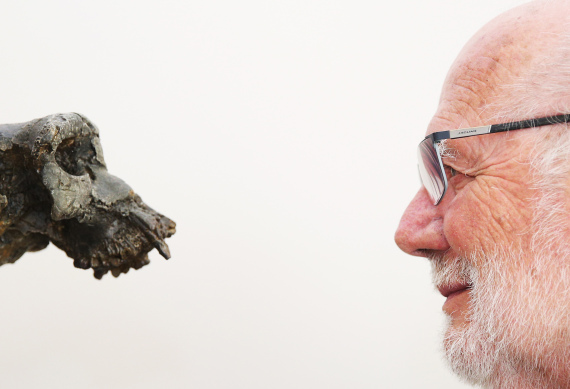Goodbye to the Ape: Seven million years ago, at the "fork in the road", he went to the human side.

On July 18, 2018, Dakar, Senegal, the Museum of Black Civilization. Xinhua News Agency reporter Yan Yanshe
Seven million years ago, in the active primate community in Africa, a figure stood up and took a small step for the individual at the "fork in the road" when the apes were about to leave, but it became a big step for mankind.
Today, this "fork in the road" is located in a remote desert in Chad. The skull left by that figure has been fossilized by the years and inadvertently exposed in front of people in the sand.
"This is the earliest known ancient human," Michel Bruehne, the leader of the fossil discovery team and a professor at the Institut fran? aise, said in an interview with Xinhua News Agency recently. "His name is Toumai, which means" hope of life "in the local language.
What is Man: The Controversy Faced by Tumai
Tumai’s skull fossil was discovered by Bruehne’s team in 2001. The original is now in the National Research and Development Center of Chad, and the replicas are exhibited in the National Museum of Chad and the Senegalese Museum of Black Civilization. Aimei Contusan, the chief researcher of the Museum of Black Civilization, said: "Tumai is considered to exist between the primate chimpanzee genus and the human genus." This expression reflects the controversy that Tumai once faced.
The facial image reconstructed from Tumai’s skull can directly explain the controversy. The hair and facial features on the reconstructed head look a bit like orangutans. Experts believe that Tumai is a male, and his fossils show the mixed characteristics of apes and humans: the skull shape is similar to that of apes, the brain volume is close to that of chimpanzees, and the orbital spacing is similar to that of gorillas.
Only three months after Bruehne’s team published a paper on Tumai in the British journal Nature in July 2002, milford Wolpov of the Paleoanthropology Laboratory of the University of Michigan and others published a questioning article in Nature in October, arguing that Tumai was still an ape rather than a human being.
However, there is also a lot of evidence to support that Tumai is a human being. Bruehne published a response article in Nature in 2005. He told reporters: "Some people say that this is a gorilla, and the canine teeth will be hollow and very large, but this is the canine teeth of human beings. The position of the foramen magnum on the skull is also different from that of gorillas and chimpanzees, but it is in line with the characteristics of human legs walking upright. "
"What is a person?" Wu Xiujie, a researcher at the Institute of vertebrate paleontology and Paleoanthropology, Chinese Academy of Sciences, pointed out in an interview with Xinhua News Agency that the focus of relevant disputes is actually the definition of human beings.
"Before the 1960s, paleoanthropologists generally used whether they could make tools as the boundary between humans and apes. However, it was later discovered that making tools is not a unique ability of human beings, and animals such as chimpanzees can also make tools. Therefore, paleoanthropologists gradually adopted a new standard: habitual walking with two legs upright. "
Wu Xiujie said that the position of the foramen magnum of Tumai’s skull is as downward as ours, indicating that the skull is vertically located on the spine, indicating that it has habitually walked upright with two legs. "This is decisive evidence." She said that the current academic classification of Tumai is the Sahelian Chad species. Although it does not belong to the genus of modern people, it belongs to the human family, which is the same as other ancient humans.

On April 8, 2009, several primary school students watched the reduced image of human ancestor fossil "Lucy" at the National Museum in Addis Ababa, Ethiopia. Xinhua News Agency reporter Deng Jianshe
"The Ape": The Fork of 7 million years ago
Since Tumai is a human being, its "age" is particularly meaningful. Bruehne’s team published a paper in the Journal of the National Academy of Sciences in 2008, saying that the dating result of Tumai skull is between 6.8 million and 7.2 million years, which is often said to be 7 million years for convenience. He said: "So far, no human beings older than this have been found."
This means that the time of human origin has been pushed forward by Tumai.
For many years, Lucy, a famous ancient human fossil, has been called "the old grandmother of mankind". This female skeleton fossil, discovered in Ethiopia in 1974, is highly valued for its completeness and antiquity. Fossils include skulls, ribs, arm bones, etc., and are the most complete fossils of their kind. Its "age" is about 3.5 million years, and it has been firmly in the top spot in the world for a long time after being discovered.
But older fossils have appeared one after another. An ancient human fossil found in Kenya in 2000 was named Millennials because of its discovery time. It was about 6 million years ago and won the throne of "the highest generation". Only one year later, Tumai was discovered in Chad, which pushed forward the time of human origin by 1 million years.
The significance of Tumai is not only in time, but also in space. Before Tumai, because important early human fossils such as Lucy were found in eastern Africa, Yves Copon, a famous French paleoanthropologist, put forward the theory of "East Story", which believed that human beings originated in the east of the Grand Canyon in East Africa. Tumai appeared in the desert of Chad in central Africa and moved about 2500 kilometers west of the Grand Canyon, breaking the theory of "East Story".
"Tumai’s discovery shows the progress of scientific research," Contusan said. "With the further development of science and technology, we may find more ancient humans."

On August 8, 2019, Michel Brunet, a professor at the French Academy, was interviewed in his office in Paris. Xinhua News Agency reporter Gao Jingshe
The blind touch the elephant: the evolutionary tree of ancestors has not yet been explored
Tumai, who stood 7 million years ago, is the earliest ancestor we can see now. Is he our ancestor?
Ordinary people may naturally have such an idea. In Chad, most people know Tumai and are proud of it. Abubakar Saleh, a citizen of Chad, said: "Tumai is the ancestor of mankind, and we are the descendants of Tumai. This is a great honor."
But in the opinion of experts, the evolutionary tree of human ancestors is far from clear. Wu Xiujie said: "Because of the scarcity of fossils, our research on the evolutionary tree of ancient humans is still blind."
Now, a mainstream view in paleoanthropology is the "African origin" of early humans, because all the ancient human fossils found 2 million years ago are in Africa. "Human beings have spent a long time in Africa," Bruehne said. From a very long time scale, "we are all Africans, and outside Africa, we are all immigrants".
However, there is still controversy in academic circles about how modern people originated in more recent places. For example, for the ancestors of Chinese, there is an international view that although there were Yuanmou people 1.7 million years ago and Peking Man 770,000 years ago, these ancient humans may not have survived the Ice Age, and another group of ancient humans came out of Africa about 60,000 years ago.
Recently, however, many new fossil evidences have been found in the paleoanthropologists in China, such as Xu Changren, Dao County Man, Huanglong Cave Man, Chongzuo Homo sapiens Cave Man, etc. about 100,000 years ago. These new fossil evidences challenge the view that there are no modern people in China earlier than 60,000 years.
Wu Xiujie said: "The evolution of ancient human branches is not an isolated and linear process, but a complex bush-like process. There may be a mixture between branches, some branches may later perish, and new branches may arise somewhere. The trunk and panorama of the human evolutionary tree have not been explored yet. "
It is not clear whether Tumai is the ancestor of today’s modern people, even the Chadians. Wu Xiujie said: "But if we look at it from a particularly long time scale, we can say that Tumai and all of us modern people are relatives."
(The original title is "Special Feature: 7 million years ago, the" fork in the road ",he went to the human side")